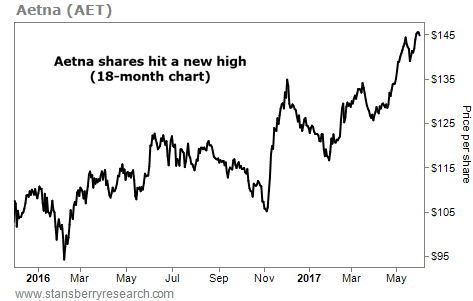| Home | About Us | Resources | Archive | Free Reports | Market Window |
Here's the Strategy Most Gurus Keep to ThemselvesBy
Friday, June 2, 2017
The world's top investors and traders have a hidden strategy.
We can't see that they're doing it...
But they are... and probably far more than we know.
It's one of the best trading strategies in the world, especially during times like right now. The stock market is full of companies that trade at rich valuations... Yet share prices keep climbing.
At some point, a big move lower will hit the market. It will shock stockholders with its suddenness and severity. And many (or most) of them will take large losses. My friend and colleague Steve Sjuggerud calls this the "Melt Down" after the big "Melt Up."
We don't want to miss out as the bull market continues... But we recommend taking precautions. They include smart asset allocation, position sizing, stop losses, and a variety of other trading strategies.
Today, we'll talk about one of these strategies. If you're not already using it, consider doing so...
It allows you to profit in stocks whether the market rises or falls. It reduces your volatility and increases your peace of mind. And it may even allow you to ride out the next big drop in stocks without taking major losses.
Once a quarter, investors who manage at least $100 million are required to file forms called "13Fs" with the U.S. Securities and Exchange Commission (SEC). These forms detail which stocks they've bought and sold from one quarter to the next... and which stocks they held at the end of the most recent quarter. By reviewing their filings, we can "look over their shoulders" for ideas.
The thing is, we get a one-sided view. These stock market gurus are only required to reveal their long positions – the stocks that they own. They aren't required to disclose their short positions – their bets on falling stocks.
This doesn't mean that doing this kind of research is useless. Elite investors usually don't buy stocks they expect to go down... So 13Fs are still a great place to scout for new ideas. But we can't tell if their long positions stand alone or are part of a more complex strategy... like a "pairs trade."
A pairs trade is when you buy one asset (betting that it will go up), sell another asset short (betting that it will go down), and treat the two positions as one trade. This results in a pair of trades that is "market neutral"...
In other words, a pairs trade is equally likely to profit, whether the asset class rises or falls. For example, if you buy one stock and short another stock in the same industry, your profits aren't tied to how that market sector performs... or even how the stock market as a whole performs.
The pair of trades generates profits if the asset you buy performs better than the asset you short. This makes pairs trades a fantastic way to make money without taking any broad market risk.
Big money managers place pairs trades to reduce the risk in specific holdings. And they sell stocks short... both to profit and to reduce the risk of holding long positions in general. This all fits into how they allocate their assets...
But this guru activity is hidden from the public, unless they talk about it...
Jeff Gundlach is a great example. He's one of the world's top bond experts. And he manages more than $100 billion in his fund, DoubleLine Capital. Over the years, Gundlach has announced new pairs-trading ideas at big investment conferences like the Ira Sohn Conference last month.
In 2012, he recommended shorting Apple (AAPL) and buying natural gas. The pair of contrarian trades resulted in an enormous profit. Last year, Gundlach recommended shorting utilities and buying a mortgage real estate fund, also a winning trade. And earlier this month, he announced that he was shorting U.S. stocks and buying emerging markets.
Most gurus keep these ideas to themselves. We only know about Gundlach's pairs trades because he promoted them. Still, we can't know for sure that he followed his own advice. But we do know the effect of these trades... and that his ideas have been profitable.
Stansberry Research founder Porter Stansberry is also a fan of pairs trading. Last April, he explained...
Consider how you can turn some of your upcoming (or even recent) long positions into pairs trades... Are you going to buy a high-flying tech stock? You might consider shorting a fund that tracks the tech sector. Are you going to buy an energy stock you think will outperform? Consider pairing it with a short position in a fund that tracks energy stocks... or with a short position in an energy stock that you think will perform worse than the rest of the sector.
The stock market is in extreme territory. You don't want to be out of stocks completely because the bull market could continue for months, or years, with big gains to come. But you don't want to ignore the risk, either.
Pairs trading with a portion of your portfolio is an excellent solution. You can take part in the profits without increasing your overall risk. It's a hidden guru strategy that you should be using.
Good trading,
Ben Morris
Further Reading:
"You'll likely spot great opportunities that others don't," Ben writes. Watching the markets for certain big buys can give you an advantage... But most folks don't know it. Learn what to look for right here: Do You Use This Trading Tool to Get an Edge?
"You can look at a specific number for just about any stock you want to trade," Ben says. "When it's big enough, it can help you make a lot of money, very quickly." Learn how and when to use this tool effectively right here: Use This Little-Known Number to Find Explosive Stocks.
Market NotesTHIS BUSINESS FUNDS THE HEALTH CARE TREND Today, we'll highlight the success of a leading insurance provider...
Last week, we reminded readers about our colleague Dave Eifrig's bullish call on health care stocks. He has argued that the aging Baby Boomer generation will drive big gains in health care stocks. As the Boomers get older, they'll need more medicine, testing, and visits to the doctor. And that also means they'll need insurance plans to afford these things...
For more proof, we'll look at shares of health care benefits provider Aetna (AET). The company serves nearly 45 million people with a variety of insurance plans – including medical, pharmacy, dental, disability, and life insurance. During its latest quarter, Aetna increased its full-year profit forecast. And in February, the company announced a $3.3 billion share buyback. This move shows Aetna's financial strength and stability...
As you can see below, Aetna's shares have responded to the news. They're up more than 20% since the end of January... And they just hit a fresh all-time high. Dave's bet on health care continues to be right on the money...
 |
Recent Articles
|



